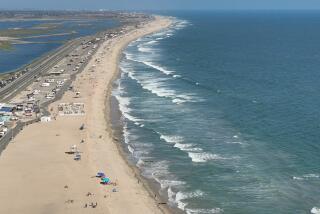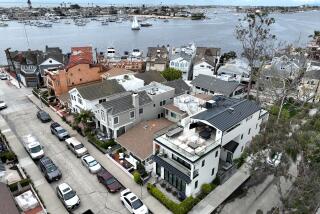LIDO ISLE : FOCUS : High-Style Island Living
- Share via
Affluent, quaint and nautical are just a few of the terms that come to mind when one thinks of Lido Isle and Village. The beach--endowed with beauty for as far as the eye can see--belongs to the waterfront homeowners, and, where there are no homes, the land is owned by the city of Newport Beach.
Once you cross the Lido Isle Bridge you are in the village--situated between Balboa Island and the bay. The village is lined with uncurbed cobblestone streets. European-style boutiques, cafes, condos and markets dominate the village. The cafes feature international cuisine and are filled with boat and yacht brokers, merchants and tourists.
One longtime resident recalls the 1930s when the city was virtually trying to give away the land. Today Lido Isle is some of the most expensive property in Orange County. She also recollects working for a pharmacy and delivering prescriptions to Spencer Tracy’s house, this during the era when Lido was something of a hub for Hollywood celebrities.
In 1890 the state of California sold 1,000 acres of Newport Beach to the McFadden brothers, James and Robert, for $1,000. It thereby granted them title to the area now known as Lido and Balboa islands. The state sweetened the deal by also giving them title to the land between 9th and 14th streets on the peninsula.
By 1896 the McFaddens had built a railroad spur line to service their celery fields on the islands. They also lobbied the federal government for harbor improvements. But Washington, unable to grasp the advantages the changes would bring, disallowed the improvements.
In the early 1900s the Pacific Electric Co. (a trolley company) had acquired Lido Isle--still a mere mud flat--and sold it to W.K. Parkinson in 1923. Parkinson, an oil millionaire, made the purchase for $45,000; he called it Parkinson Island. He dredged it, raised it and began developing a resort similar to the Venice (Italy) Lido, which led to the current name.
After Parkinson died, the land passed to the Griffith Co., and with the help of Paul (Pappy) Palmer, an extraordinary real estate promoter, the company made the island one of the finest real estate success stories in Southern California. Pappy’s motto: “A little buys a lot.” If he were promoting land today, we could be seeing him on “Lifestyles of the Rich and Famous.”
Population Population: (1988 est.) 2,118 1980-88 change: +3% Median Age: 46.8 years By sex and age: MALES Median age: 44.4 years FEMALES Median age: 48.8 years Racial/ethnic mix: White (non-Hispanic), 95%; Hispanic, 4%; Black, Less than 1%; Other, 1% Income Per capita: $52,729 Median Household: 81,667 Average Household: 131,927 Household Distribution: $50,000-74,999: 20% More than $75,000: 52% Less than $25,000: 10% $25,000-49,999: 18%
More to Read
Sign up for The Wild
We’ll help you find the best places to hike, bike and run, as well as the perfect silent spots for meditation and yoga.
You may occasionally receive promotional content from the Los Angeles Times.





